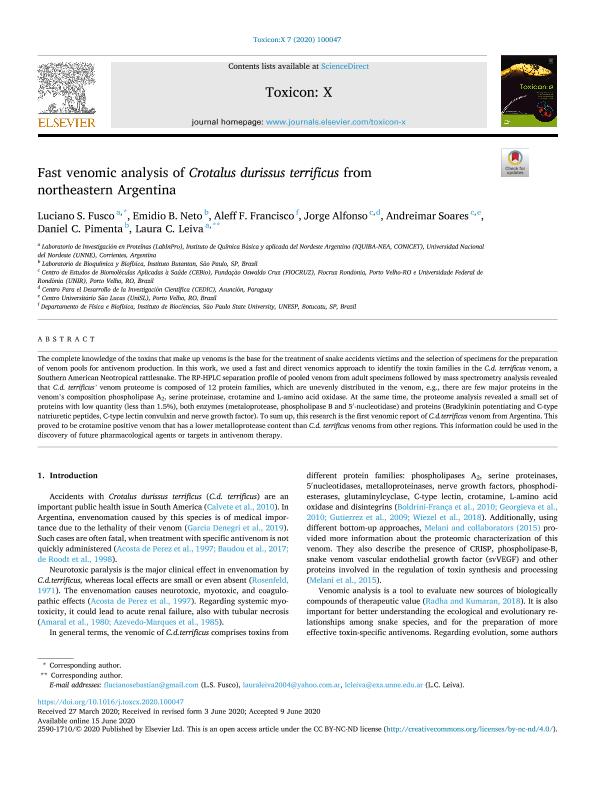Artículo
Fast venomic analysis of Crotalus durissus terrificus from northeastern Argentina
Fusco, Luciano Sebastian ; Neto, Emidio B.; Francisco, Aleff F.; Alfonso, Jorge; Soares, Andreimar; Pimenta, Daniel C.; Leiva, Laura Cristina Ana
; Neto, Emidio B.; Francisco, Aleff F.; Alfonso, Jorge; Soares, Andreimar; Pimenta, Daniel C.; Leiva, Laura Cristina Ana
 ; Neto, Emidio B.; Francisco, Aleff F.; Alfonso, Jorge; Soares, Andreimar; Pimenta, Daniel C.; Leiva, Laura Cristina Ana
; Neto, Emidio B.; Francisco, Aleff F.; Alfonso, Jorge; Soares, Andreimar; Pimenta, Daniel C.; Leiva, Laura Cristina Ana
Fecha de publicación:
09/2020
Editorial:
Elsevier
Revista:
Toxicon: X
ISSN:
2590-1710
Idioma:
Inglés
Tipo de recurso:
Artículo publicado
Clasificación temática:
Resumen
The complete knowledge of the toxins that make up venoms is the base for the treatment of snake accidents victims and the selection of specimens for the preparation of venom pools for antivenom production. In this work, we used a fast and direct venomics approach to identify the toxin families in the C.d. terrificus venom, a Southern American Neotropical rattlesnake. The RP-HPLC separation profile of pooled venom from adult specimens followed by mass spectrometry analysis revealed that C.d. terrificus’ venom proteome is composed of 12 protein families, which are unevenly distributed in the venom, e.g., there are few major proteins in the venom's composition phospholipase A2, serine proteinase, crotamine and L-amino acid oxidase. At the same time, the proteome analysis revealed a small set of proteins with low quantity (less than 1.5%), both enzymes (metaloprotease, phospholipase B and 5′-nucleotidase) and proteins (Bradykinin potentiating and C-type natriuretic peptides, C-type lectin convulxin and nerve growth factor). To sum up, this research is the first venomic report of C.d.terrificus venom from Argentina. This proved to be crotamine positive venom that has a lower metalloprotease content than C.d. terrificus venoms from other regions. This information could be used in the discovery of future pharmacological agents or targets in antivenom therapy.
Palabras clave:
VENOM
,
CROTALUS DIRISSUS TERRIFICUS
,
FAST VENOMIC ANALYSIS
,
ARGENTINA
Archivos asociados
Licencia
Identificadores
Colecciones
Articulos(IQUIBA-NEA)
Articulos de INSTITUTO DE QUIMICA BASICA Y APLICADA DEL NORDESTE ARGENTINO
Articulos de INSTITUTO DE QUIMICA BASICA Y APLICADA DEL NORDESTE ARGENTINO
Citación
Fusco, Luciano Sebastian; Neto, Emidio B.; Francisco, Aleff F.; Alfonso, Jorge; Soares, Andreimar; et al.; Fast venomic analysis of Crotalus durissus terrificus from northeastern Argentina; Elsevier; Toxicon: X; 7; 9-2020; 1-7
Compartir
Altmétricas



